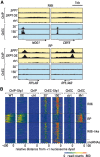Sfp1 regulates transcriptional networks driving cell growth and division through multiple promoter-binding modes
- PMID: 30804227
- PMCID: PMC6411004
- DOI: 10.1101/gad.322040.118
Sfp1 regulates transcriptional networks driving cell growth and division through multiple promoter-binding modes
Abstract
The yeast Sfp1 protein regulates both cell division and growth but how it coordinates these processes is poorly understood. We demonstrate that Sfp1 directly controls genes required for ribosome production and many other growth-promoting processes. Remarkably, the complete set of Sfp1 target genes is revealed only by a combination of ChIP (chromatin immunoprecipitation) and ChEC (chromatin endogenous cleavage) methods, which uncover two promoter binding modes, one requiring a cofactor and the other a DNA-recognition motif. Glucose-regulated Sfp1 binding at cell cycle "START" genes suggests that Sfp1 controls cell size by coordinating expression of genes implicated in mass accumulation and cell division.
Keywords: G1/S regulon; START; Sfp1; cell cycle; cell growth; chromatin endogenous cleavage (ChEC); ribosomal protein gene; ribosome biogenesis; transcription.
© 2019 Albert et al.; Published by Cold Spring Harbor Laboratory Press.
Figures





Similar articles
-
Sfp1 interaction with TORC1 and Mrs6 reveals feedback regulation on TOR signaling.Mol Cell. 2009 Mar 27;33(6):704-16. doi: 10.1016/j.molcel.2009.01.034. Mol Cell. 2009. PMID: 19328065
-
Saccharomyces cerevisiae SFP1: at the crossroads of central metabolism and ribosome biogenesis.Microbiology (Reading). 2008 Jun;154(Pt 6):1686-1699. doi: 10.1099/mic.0.2008/017392-0. Microbiology (Reading). 2008. PMID: 18524923
-
The zinc-finger transcription factor Sfp1 imprints specific classes of mRNAs and links their synthesis to cytoplasmic decay.Elife. 2024 Oct 2;12:RP90766. doi: 10.7554/eLife.90766. Elife. 2024. PMID: 39356734 Free PMC article.
-
Transcriptional control of ribosome biogenesis in yeast: links to growth and stress signals.Biochem Soc Trans. 2021 Aug 27;49(4):1589-1599. doi: 10.1042/BST20201136. Biochem Soc Trans. 2021. PMID: 34240738 Free PMC article. Review.
-
Scaling gene expression for cell size control and senescence in Saccharomyces cerevisiae.Curr Genet. 2021 Feb;67(1):41-47. doi: 10.1007/s00294-020-01098-4. Epub 2020 Nov 5. Curr Genet. 2021. PMID: 33151380 Free PMC article. Review.
Cited by
-
Special Issue: Yeast Cell Signaling Pathways (Volume 1).Int J Mol Sci. 2023 Mar 3;24(5):4929. doi: 10.3390/ijms24054929. Int J Mol Sci. 2023. PMID: 36902357 Free PMC article.
-
Homotypic cooperativity and collective binding are determinants of bHLH specificity and function.Proc Natl Acad Sci U S A. 2019 Aug 6;116(32):16143-16152. doi: 10.1073/pnas.1818015116. Epub 2019 Jul 24. Proc Natl Acad Sci U S A. 2019. PMID: 31341088 Free PMC article.
-
Comparative Research: Regulatory Mechanisms of Ribosomal Gene Transcription in Saccharomyces cerevisiae and Schizosaccharomyces pombe.Biomolecules. 2023 Feb 3;13(2):288. doi: 10.3390/biom13020288. Biomolecules. 2023. PMID: 36830657 Free PMC article. Review.
-
A comprehensive transcription factor and DNA-binding motif resource for the construction of gene regulatory networks in Botrytis cinerea and Trichoderma atroviride.Comput Struct Biotechnol J. 2021 Nov 18;19:6212-6228. doi: 10.1016/j.csbj.2021.11.012. eCollection 2021. Comput Struct Biotechnol J. 2021. PMID: 34900134 Free PMC article.
-
Integrated TORC1 and PKA signaling control the temporal activation of glucose-induced gene expression in yeast.Nat Commun. 2019 Aug 8;10(1):3558. doi: 10.1038/s41467-019-11540-y. Nat Commun. 2019. PMID: 31395866 Free PMC article.
References
Publication types
MeSH terms
Substances
LinkOut - more resources
Full Text Sources
Molecular Biology Databases
